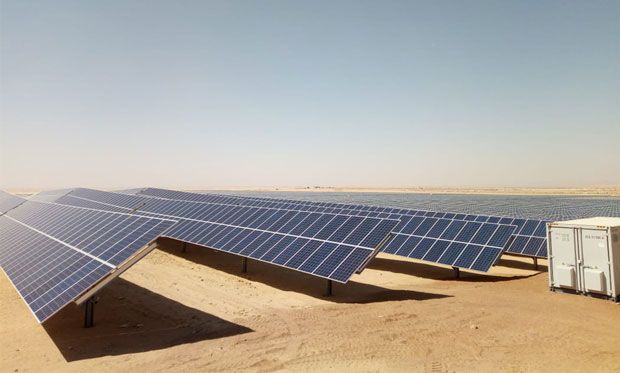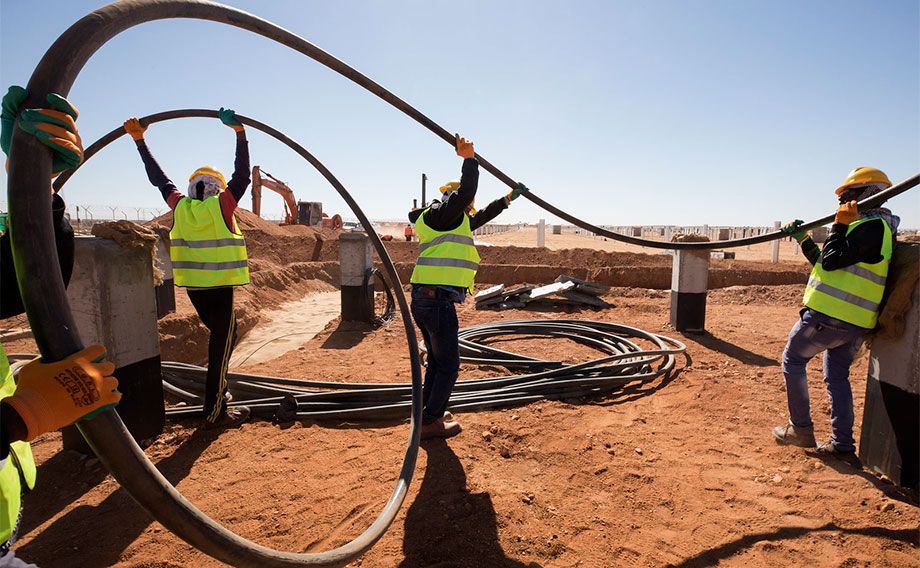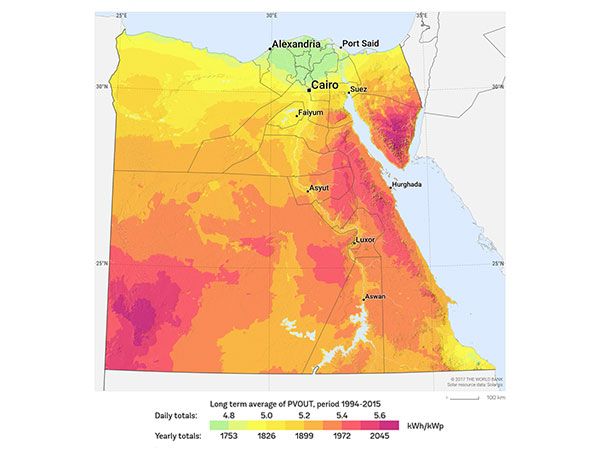Egypt’s Massive 1.8-Gigawatt Benban Solar Park Nears Completion
Amid the sand dunes of the eastern Sahara, workers are putting the finishing touches on one of the world's largest solar installations. There, as many as 7.2 million photovoltaic panels will make up Benban Solar Park-a renewable energy project so massive, it will be visible from space.
The 1.8-gigawatt installation is the first utility-scale PV plant in Egypt, a nation blessed with some of the best solar resources on the planet. The ambitious project is part of Egypt's efforts to increase its generation capacity and incorporate more renewable sources into the mix.
"I think Benban Solar Park is the first real step to put Egypt on the solar production world map," says Mohamed Orabi, a professor of power electronics at Aswan University.
Climate change is an increasingly urgent issue for Egyptians and much of the world. Already, global sea and air surface temperatures have risen by an average of 1 degree C above pre-industrial levels, according to the Intergovernmental Panel on Climate Change. In Egypt, global warming will reduce agricultural productivity, induce flooding in the fertile Nile Delta, and cause more people to die from heat stress.
Next week, world leaders will gather in New York for the United Nations Climate Action Summit, where they're expected to present "concrete, realistic plans" to limit global warming to no more than 1.5 degrees Celsius. Low-carbon energy systems played a key role in a mitigation plan [PDF] that Egypt submitted in advance of the 2015 Paris Agreement. Once operational, Benban Solar Park will avoid two million tons of CO2 emissions per year [PDF] compared with what's belched into the air by a thermal power station generating the same amount of electricity. That difference is roughly equivalent to half the annual emissions produced by one coal-fired power plant.
To create the park, Egypt's government selected a remote desert site with high solar radiation and divided it into 41 plots of varying sizes. It assigned those plots to roughly 30 developers that expressed interest in the project, and the government promised to pay a competitive price (through financial incentives called feed-in tariffs [PDF]) for all power produced at Benban for 25 years.
 Photo: Mohamed El-sheikh Egypt's Benban Solar Park has an expected lifespan of 25 years.
Photo: Mohamed El-sheikh Egypt's Benban Solar Park has an expected lifespan of 25 years. With loans from the International Finance Corporation and the World Bank, the state-owned Egyptian Electricity Holding Company built roads and other infrastructure at the site, including four substations, a control center, and a connection to an adjacent corridor of 220-kilovolt (kV) transmission lines. (In the future, the utility may also connect the park to two 500-kV high-voltage transmission lines that pass nearby.)
The developers, which include Alcazar Energy, IB Vogt, Scatec Solar, and Shapoorji Pallonji, installed panels, transformers, and inverters on their respective plots. The plots are arranged in four rows, each with a substation at the end. Electricity travels from the panels on each plot to the substations through 22-kV cables buried in the sand.
 Photo: Dominic Chavez/IFC Workers carry medium-voltage cables at Benban Solar Park in Egypt.
Photo: Dominic Chavez/IFC Workers carry medium-voltage cables at Benban Solar Park in Egypt. Mohamed Elsheikh, a contractor who has worked at Benban, says the desert site now looks like "a big ocean" of photovoltaics. Orabi, who has consulted on several projects at the park, estimates that more than 80 percent of installations there are now complete.
For the most part, Orabi says, construction at Benban has been smooth, despite delays in installing the substations and some issues with the site's automated control system that have forced it to be manually operated for now.
Ibrahim Helal, an electrical consultant in Cairo, warns that the area's high temperatures-which frequently top 38 degrees C (100 degrees F) in the summer-could affect the site's many inverters, which convert the DC power produced by the panels to the AC power required for the grid. "These electrical devices are really sensitive to temperature," he says.
Elsheikh, head of the electrical department at Emeco, says Schneider Electric did have to repair one inverter at the site after its cable connection overheated. But overall, he says, his team installed more than 200,000 panels without a hitch. "The failures have been a very, very small percentage," he says.
High temperatures can also reduce the efficiency of PV cells, as can sand or dust that blows onto the panels. To combat the latter, employees will clean all the panels at Benban once or twice a month by passing by in specialized tractors equipped with brushes.
 Illustration: Global Solar Atlas This map shows high photovoltaic power potential in Egypt, where the sun shines for 9 to 11 hours a day all year.
Illustration: Global Solar Atlas This map shows high photovoltaic power potential in Egypt, where the sun shines for 9 to 11 hours a day all year. Egypt began laying the groundwork for the US $4 billion Benban project after enduring repeated blackouts, caused by severe fuel shortages, that reached their worst point in August 2014. At the time, peak demand was 28 GW but the country's production was limited to just 24 GW.
Around that time, Egypt's government signed a deal with Siemens to construct three new gas-fired combined-cycle power plants, each with a capacity of 4.8 GW. Those power plants are now also coming online.
Helal believes all of these investments have positioned Egypt well for its future. "Egypt now is growing very fast," he says. "Even though it may look at the moment like we have a huge reserve of energy, I believe in the forthcoming few years, this will be consumed."
Orabi thinks the next step for Benban should be to invest in energy storage to ensure the power produced there is put to good use, and to help smooth out any grid fluctuations.
Egypt's government has set a goal for 20 percent of the nation's electricity to come from renewable sources by 2022, and 42 percent by 2035. The country's potential may be even greater: A 2018 report by the International Renewable Energy Agency concluded that Egypt could "realistically draw 53 percent of its electricity from renewables by 2030." In 2016, about 9 percent of Egypt's electricity [PDF] came from renewable sources, and mostly from dams along the Nile River.
Orabi says the Benban project has already played three important roles in helping solar to claim a greater share of Egypt's electricity supply. First, the project drove down the cost of PV systems in Egypt. Second, it proved that solar could be a viable source of energy there, after several high-profile flops of concentrated solar projects. And lastly, Orabi says, it granted valuable experience in installing PV systems to more than 3,000 Egyptians who worked at the site.
Benban was the first utility-scale solar PV project that Elsheikh had ever managed in his career, which had always centered on rooftop installations. After his firm completed a Benban project for the company IB Vogt, Elsheikh soon heard from other developers that needed help with their own projects there. He says Benban has already started to inspire investors to consider building more utility-scale solar PV projects in Egypt.
"We have now a lot of interest," he says. "I'm so proud that I worked on this."
Editor's note: This story is published in cooperation with more than 250 media organizations and independent journalists that have focused their coverage on climate change ahead of the UN Climate Action Summit. IEEE Spectrum's participation in the Covering Climate Now partnership builds on our past reporting about this global issue.
This story was updated on 18 September 2019.